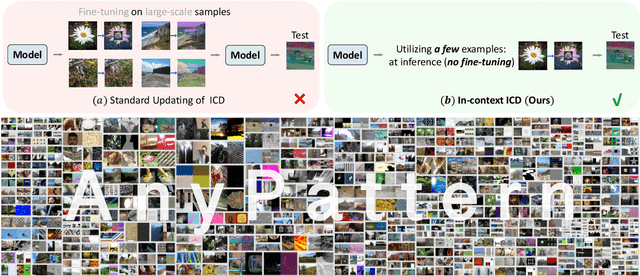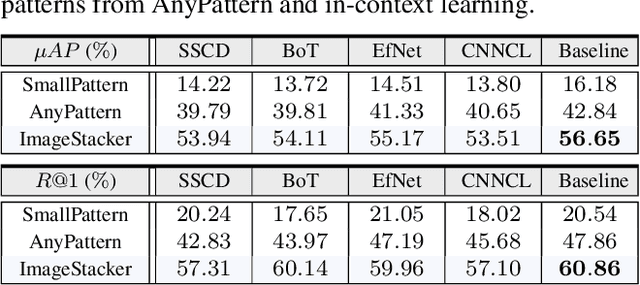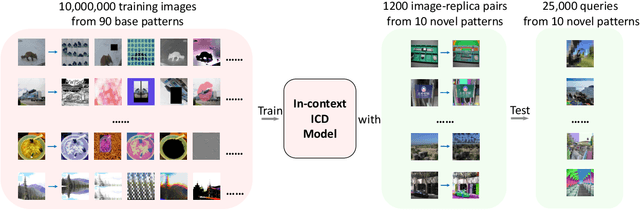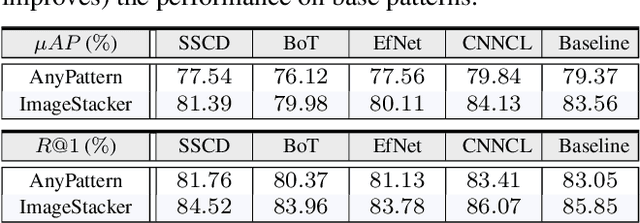Yifan Sun
Assessing Model Generalization in Vicinity
Jun 13, 2024



Abstract:This paper evaluates the generalization ability of classification models on out-of-distribution test sets without depending on ground truth labels. Common approaches often calculate an unsupervised metric related to a specific model property, like confidence or invariance, which correlates with out-of-distribution accuracy. However, these metrics are typically computed for each test sample individually, leading to potential issues caused by spurious model responses, such as overly high or low confidence. To tackle this challenge, we propose incorporating responses from neighboring test samples into the correctness assessment of each individual sample. In essence, if a model consistently demonstrates high correctness scores for nearby samples, it increases the likelihood of correctly predicting the target sample, and vice versa. The resulting scores are then averaged across all test samples to provide a holistic indication of model accuracy. Developed under the vicinal risk formulation, this approach, named vicinal risk proxy (VRP), computes accuracy without relying on labels. We show that applying the VRP method to existing generalization indicators, such as average confidence and effective invariance, consistently improves over these baselines both methodologically and experimentally. This yields a stronger correlation with model accuracy, especially on challenging out-of-distribution test sets.
Dense Connector for MLLMs
May 22, 2024



Abstract:Do we fully leverage the potential of visual encoder in Multimodal Large Language Models (MLLMs)? The recent outstanding performance of MLLMs in multimodal understanding has garnered broad attention from both academia and industry. In the current MLLM rat race, the focus seems to be predominantly on the linguistic side. We witness the rise of larger and higher-quality instruction datasets, as well as the involvement of larger-sized LLMs. Yet, scant attention has been directed towards the visual signals utilized by MLLMs, often assumed to be the final high-level features extracted by a frozen visual encoder. In this paper, we introduce the Dense Connector - a simple, effective, and plug-and-play vision-language connector that significantly enhances existing MLLMs by leveraging multi-layer visual features, with minimal additional computational overhead. Furthermore, our model, trained solely on images, showcases remarkable zero-shot capabilities in video understanding as well. Experimental results across various vision encoders, image resolutions, training dataset scales, varying sizes of LLMs (2.7B->70B), and diverse architectures of MLLMs (e.g., LLaVA and Mini-Gemini) validate the versatility and scalability of our approach, achieving state-of-the-art performance on across 19 image and video benchmarks. We hope that this work will provide valuable experience and serve as a basic module for future MLLM development.
Get more for less: Principled Data Selection for Warming Up Fine-Tuning in LLMs
May 05, 2024



Abstract:This work focuses on leveraging and selecting from vast, unlabeled, open data to pre-fine-tune a pre-trained language model. The goal is to minimize the need for costly domain-specific data for subsequent fine-tuning while achieving desired performance levels. While many data selection algorithms have been designed for small-scale applications, rendering them unsuitable for our context, some emerging methods do cater to language data scales. However, they often prioritize data that aligns with the target distribution. While this strategy may be effective when training a model from scratch, it can yield limited results when the model has already been pre-trained on a different distribution. Differing from prior work, our key idea is to select data that nudges the pre-training distribution closer to the target distribution. We show the optimality of this approach for fine-tuning tasks under certain conditions. We demonstrate the efficacy of our methodology across a diverse array of tasks (NLU, NLG, zero-shot) with models up to 2.7B, showing that it consistently surpasses other selection methods. Moreover, our proposed method is significantly faster than existing techniques, scaling to millions of samples within a single GPU hour. Our code is open-sourced (Code repository: https://anonymous.4open.science/r/DV4LLM-D761/ ). While fine-tuning offers significant potential for enhancing performance across diverse tasks, its associated costs often limit its widespread adoption; with this work, we hope to lay the groundwork for cost-effective fine-tuning, making its benefits more accessible.
AnyPattern: Towards In-context Image Copy Detection
Apr 28, 2024



Abstract:This paper explores in-context learning for image copy detection (ICD), i.e., prompting an ICD model to identify replicated images with new tampering patterns without the need for additional training. The prompts (or the contexts) are from a small set of image-replica pairs that reflect the new patterns and are used at inference time. Such in-context ICD has good realistic value, because it requires no fine-tuning and thus facilitates fast reaction against the emergence of unseen patterns. To accommodate the "seen $\rightarrow$ unseen" generalization scenario, we construct the first large-scale pattern dataset named AnyPattern, which has the largest number of tamper patterns ($90$ for training and $10$ for testing) among all the existing ones. We benchmark AnyPattern with popular ICD methods and reveal that existing methods barely generalize to novel patterns. We further propose a simple in-context ICD method named ImageStacker. ImageStacker learns to select the most representative image-replica pairs and employs them as the pattern prompts in a stacking manner (rather than the popular concatenation manner). Experimental results show (1) training with our large-scale dataset substantially benefits pattern generalization ($+26.66 \%$ $\mu AP$), (2) the proposed ImageStacker facilitates effective in-context ICD (another round of $+16.75 \%$ $\mu AP$), and (3) AnyPattern enables in-context ICD, i.e., without such a large-scale dataset, in-context learning does not emerge even with our ImageStacker. Beyond the ICD task, we also demonstrate how AnyPattern can benefit artists, i.e., the pattern retrieval method trained on AnyPattern can be generalized to identify style mimicry by text-to-image models. The project is publicly available at https://anypattern.github.io.
MS-DETR: Efficient DETR Training with Mixed Supervision
Jan 08, 2024



Abstract:DETR accomplishes end-to-end object detection through iteratively generating multiple object candidates based on image features and promoting one candidate for each ground-truth object. The traditional training procedure using one-to-one supervision in the original DETR lacks direct supervision for the object detection candidates. We aim at improving the DETR training efficiency by explicitly supervising the candidate generation procedure through mixing one-to-one supervision and one-to-many supervision. Our approach, namely MS-DETR, is simple, and places one-to-many supervision to the object queries of the primary decoder that is used for inference. In comparison to existing DETR variants with one-to-many supervision, such as Group DETR and Hybrid DETR, our approach does not need additional decoder branches or object queries. The object queries of the primary decoder in our approach directly benefit from one-to-many supervision and thus are superior in object candidate prediction. Experimental results show that our approach outperforms related DETR variants, such as DN-DETR, Hybrid DETR, and Group DETR, and the combination with related DETR variants further improves the performance.
Understanding News Creation Intents: Frame, Dataset, and Method
Dec 27, 2023



Abstract:As the disruptive changes in the media economy and the proliferation of alternative news media outlets, news intent has progressively deviated from ethical standards that serve the public interest. News intent refers to the purpose or intention behind the creation of a news article. While the significance of research on news intent has been widely acknowledged, the absence of a systematic news intent understanding framework hinders further exploration of news intent and its downstream applications. To bridge this gap, we propose News INTent (NINT) frame, the first component-aware formalism for understanding the news creation intent based on research in philosophy, psychology, and cognitive science. Within this frame, we define the news intent identification task and provide a benchmark dataset with fine-grained labels along with an efficient benchmark method. Experiments demonstrate that NINT is beneficial in both the intent identification task and downstream tasks that demand a profound understanding of news. This work marks a foundational step towards a more systematic exploration of news creation intents.
On Mask-based Image Set Desensitization with Recognition Support
Dec 14, 2023Abstract:In recent years, Deep Neural Networks (DNN) have emerged as a practical method for image recognition. The raw data, which contain sensitive information, are generally exploited within the training process. However, when the training process is outsourced to a third-party organization, the raw data should be desensitized before being transferred to protect sensitive information. Although masks are widely applied to hide important sensitive information, preventing inpainting masked images is critical, which may restore the sensitive information. The corresponding models should be adjusted for the masked images to reduce the degradation of the performance for recognition or classification tasks due to the desensitization of images. In this paper, we propose a mask-based image desensitization approach while supporting recognition. This approach consists of a mask generation algorithm and a model adjustment method. We propose exploiting an interpretation algorithm to maintain critical information for the recognition task in the mask generation algorithm. In addition, we propose a feature selection masknet as the model adjustment method to improve the performance based on the masked images. Extensive experimentation results based on multiple image datasets reveal significant advantages (up to 9.34% in terms of accuracy) of our approach for image desensitization while supporting recognition.
Data Acquisition: A New Frontier in Data-centric AI
Nov 22, 2023



Abstract:As Machine Learning (ML) systems continue to grow, the demand for relevant and comprehensive datasets becomes imperative. There is limited study on the challenges of data acquisition due to ad-hoc processes and lack of consistent methodologies. We first present an investigation of current data marketplaces, revealing lack of platforms offering detailed information about datasets, transparent pricing, standardized data formats. With the objective of inciting participation from the data-centric AI community, we then introduce the DAM challenge, a benchmark to model the interaction between the data providers and acquirers. The benchmark was released as a part of DataPerf. Our evaluation of the submitted strategies underlines the need for effective data acquisition strategies in ML.
Hyperbolic Space with Hierarchical Margin Boosts Fine-Grained Learning from Coarse Labels
Nov 18, 2023Abstract:Learning fine-grained embeddings from coarse labels is a challenging task due to limited label granularity supervision, i.e., lacking the detailed distinctions required for fine-grained tasks. The task becomes even more demanding when attempting few-shot fine-grained recognition, which holds practical significance in various applications. To address these challenges, we propose a novel method that embeds visual embeddings into a hyperbolic space and enhances their discriminative ability with a hierarchical cosine margins manner. Specifically, the hyperbolic space offers distinct advantages, including the ability to capture hierarchical relationships and increased expressive power, which favors modeling fine-grained objects. Based on the hyperbolic space, we further enforce relatively large/small similarity margins between coarse/fine classes, respectively, yielding the so-called hierarchical cosine margins manner. While enforcing similarity margins in the regular Euclidean space has become popular for deep embedding learning, applying it to the hyperbolic space is non-trivial and validating the benefit for coarse-to-fine generalization is valuable. Extensive experiments conducted on five benchmark datasets showcase the effectiveness of our proposed method, yielding state-of-the-art results surpassing competing methods.
Absolute Policy Optimization
Oct 20, 2023



Abstract:In recent years, trust region on-policy reinforcement learning has achieved impressive results in addressing complex control tasks and gaming scenarios. However, contemporary state-of-the-art algorithms within this category primarily emphasize improvement in expected performance, lacking the ability to control over the worst-case performance outcomes. To address this limitation, we introduce a novel objective function; by optimizing which, it will lead to guaranteed monotonic improvement in the lower bound of near-total performance samples (absolute performance). Considering this groundbreaking theoretical advancement, we then refine this theoretically grounded algorithm through a series of approximations, resulting in a practical solution called Absolute Policy Optimization (APO). Our experiments demonstrate the effectiveness of our approach across challenging continuous control benchmark tasks and extend its applicability to mastering Atari games. Our findings reveal that APO significantly outperforms state-of-the-art policy gradient algorithms, resulting in substantial improvements in both expected performance and worst-case performance.
 Add to Chrome
Add to Chrome Add to Firefox
Add to Firefox Add to Edge
Add to Edge